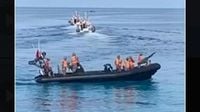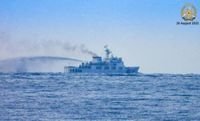Filipino forces are on heightened alert this week as China intensifies its maritime presence near the disputed Second Thomas Shoal—known locally as Ayungin Shoal—in the South China Sea. The move comes after a dramatic series of maneuvers by the China Coast Guard, which included deploying heavily armed small boats, conducting water cannon drills, and flying military aircraft over the contested area, according to multiple reports from the Armed Forces of the Philippines (AFP) and international news outlets.
On August 20, 2025, an AFP maritime domain awareness patrol observed a significant increase in Chinese activity at Second Thomas Shoal. The Philippine military reported spotting 11 China Coast Guard watercraft, including armed fast boats and rigid-hulled inflatable boats, conducting coordinated exercises. What set this deployment apart from previous incidents was the clear upgrade in firepower—several Chinese small boats were now equipped with mounted heavy machine guns, a development Manila has described as a worrying escalation.
"Some of the CCG’s fast boats were also observed to have been upgraded with mounted weapons, including heavy crew-served weapons," the AFP stated in a release, as reported by GMA Integrated News. A video released by the Philippine authorities showed a Chinese small boat, bristling with a heavy machine gun and manned by personnel in camouflage uniforms, approaching a Philippine patrol vessel. This visual evidence underscored a more aggressive posture from Beijing, which has long asserted sweeping claims over the South China Sea—claims that overlap with those of the Philippines, Vietnam, Malaysia, Brunei, and Indonesia.
The Chinese show of force was not limited to boats. The AFP noted the presence of Chinese military aircraft, including an unmanned aerial vehicle and a navy helicopter, circling above the shoal during the exercises. Adding to the tension, nine Chinese maritime militia vessels were also observed in the vicinity, and five China Coast Guard cutters were seen practicing the use of water cannons—a tactic that has previously been employed to block or disrupt Philippine resupply missions to the shoal.
This latest deployment is part of what analysts are calling a "hardened" Chinese presence in the South China Sea, following a series of confrontations and a particularly serious incident at nearby Scarborough Shoal. Just days before, on August 11, 2025, a collision occurred between a Chinese destroyer and a cutter during a high-stakes pursuit of a Philippine Coast Guard ship—the most severe clash in the region in recent memory. In response, the U.S. Navy dispatched the destroyer USS Higgins and the littoral combat ship USS Cincinnati to conduct a freedom of navigation operation near Scarborough Shoal on August 13, 2025. During this operation, the American vessels encountered two People’s Liberation Army Navy frigates, highlighting the growing risk of a wider confrontation in these crowded and contested waters.
Ben Lewis, a co-founder of PLATracker, an organization that monitors Chinese military activity, told USNI News that the deployment of armed rigid-hulled inflatable boats, with support from PLA rotary-wing and unmanned aircraft, signals a deliberate effort by Beijing to deter further Philippine attempts to assert sovereignty in the area. "The deployment of armed [rigid hull inflatable boats], supported by PLA rotary-wing and unmanned aircraft, suggests that Beijing is seeking to deter Manila from further attempts to enter the area and increase general awareness and coordination between its forces following the collision," Lewis said. He added, "The biggest question that remains is whether the behavior of PRC forces in future direct encounters with Philippine vessels will escalate, which Beijing has threatened to do."
The Philippine government, for its part, has made clear that it will not back down. "The AFP’s MDA activities form part of its continuing monitoring and reporting on developments in the West Philippine Sea as we remain committed to safeguarding Philippine sovereignty and protecting our troops stationed in the area," the AFP said in an official statement. The resolve is rooted in both national pride and international law: in 2016, the Permanent Court of Arbitration in The Hague ruled in favor of the Philippines, finding that China's broad claims to the South China Sea had no legal basis. However, Beijing has refused to recognize the decision and has continued to expand its presence throughout the region.
The situation reached a particularly tense moment on June 17, 2024, when China Coast Guard personnel, equipped with similar small boats and camouflage fatigues, clashed with Philippine Navy SEALs at Second Thomas Shoal. The confrontation resulted in a Philippine marine losing a finger, further fueling anti-China sentiment in the Philippines and drawing international condemnation.
Fast forward to August 21, 2025: the AFP reported that five China Coast Guard vessels, 11 fast boats, and nine maritime militia ships were again spotted in the area of Ayungin Shoal. These vessels were seen conducting water cannon drills late into the night, reinforcing concerns in Manila that China is preparing for more aggressive tactics. Filipino forces were promptly put on alert, as reported by CTV News, in response to what officials described as a clear and present danger to Philippine sovereignty.
The stakes are high for both sides. For the Philippines, the shoal is a critical outpost for asserting its rights in the West Philippine Sea, a term it uses to describe the portion of the South China Sea within its exclusive economic zone. For China, control over these waters is seen as vital to its strategic interests and regional ambitions. Despite the 2016 arbitration ruling, Beijing continues to build up its military and coast guard assets in the area, often using maritime militia vessels—ostensibly civilian boats that operate under military direction—to bolster its claims and intimidate rivals.
Meanwhile, the United States has reiterated its commitment to supporting the Philippines under the Mutual Defense Treaty, and the presence of American warships in recent operations is a not-so-subtle reminder to Beijing that any escalation could have broader consequences. Still, the risk of miscalculation remains ever-present, especially as both sides increase their patrols and the hardware they bring to bear.
As of this week, the situation around Second Thomas Shoal remains tense and unpredictable. With both Filipino and Chinese forces dug in and refusing to yield ground, the region is bracing for what could be the next flashpoint in the long-running struggle for control of the South China Sea. Whether diplomacy can prevail over gunboats and water cannons is anyone’s guess—but for now, all eyes are on the contested waters off the Philippine coast, where the next move could shape the balance of power in Southeast Asia for years to come.




